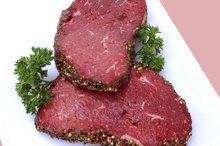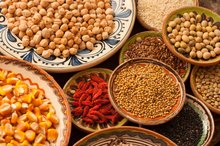What does fact checked mean?
At Healthfully, we strive to deliver objective content that is accurate and up-to-date. Our team periodically reviews articles in order to ensure content quality. The sources cited below consist of evidence from peer-reviewed journals, prominent medical organizations, academic associations, and government data.
- Medlineplus: Protein in Diet
- National Heart Lung and Blood Institute: How is Anemia Treated?
- National Heart Lung and Blood Institute: How is Anemia Treated?
- Office of Dietary Supplements: Iron
- Linus Pauling Institute: Vitamin C
The information contained on this site is for informational purposes only, and should not be used as a substitute for the advice of a professional health care provider. Please check with the appropriate physician regarding health questions and concerns. Although we strive to deliver accurate and up-to-date information, no guarantee to that effect is made.
Foods That Make New Cells in the Body
Cells are the smallest units of the human body and all the functions of the body actually take place at the cellular level. In fact, the life of a human being begins as a single cell and formation of new cells is crucial to an organism's growth and development. Cells are constantly replaced by new cells, although the process slows down as you age. The formation of new cells helps prevent age-related conditions in the body and maintain overall health and vitality.
Proteins
Proteins are complex chains of amino acids found in skin, muscles, organs, glands and bodily fluids. According to MedlinePlus, proteins are essential to make new cells and to repair old cells. Proteins are also part of the chromosomes that help express the genetic code present in the DNA in new cells. Foods such as meat, poultry, eggs, soybeans and dairy products are sources of complete proteins and contain all the essential amino acids that cannot be produced within the body from other nutrients and compounds. Beans, peas, nuts and seeds are sources of incomplete proteins and lack some of the essential amino acids. The amount of protein you require depends upon age and overall health. Protein supplements, however, are rarely required by healthy individuals.
- Proteins are complex chains of amino acids found in skin, muscles, organs, glands and bodily fluids.
- Foods such as meat, poultry, eggs, soybeans and dairy products are sources of complete proteins and contain all the essential amino acids that cannot be produced within the body from other nutrients and compounds.
B Vitamins
Anemia & Vitamin K
Learn More
B vitamins such as folic acid and vitamin B-12 are water-soluble nutrients essential for the formation of new cells, especially new red blood cells, in the body. The National Heart Lung and Blood Institute states that you can obtain sufficient amounts of vitamin B-12 from meats, eggs, dairy products and fortified cereals to help avoid conditions such as pernicious anemia that occur due to the decreased production of red blood cells in the body 24. Folic acid, which plays a crucial role in the formation of new cells and helps pregnant women avoid anemia, can be obtained from green, leafy vegetables, black-eyed peas, dried beans, eggs, bananas and oranges.
Iron
Iron is an essential mineral for human nutrition and is an important component of several body proteins and enzymes. Iron plays a major role in the transport of oxygen to the body cells, which is required for energy production in cells and, in turn, for reproduction. The National Institutes of Health’s Office of Dietary Supplements recommends 8 to 11 mg of iron per day, depending upon the age of the patient 3. Meat, broccoli, spinach, kidney beans and lentils are good sources of iron. Synthetic iron supplements may be considered for people with iron deficiency and for pregnant women 3. However, it is important to talk to a doctor before taking these supplements.
- Iron is an essential mineral for human nutrition and is an important component of several body proteins and enzymes.
- The National Institutes of Health’s Office of Dietary Supplements recommends 8 to 11 mg of iron per day, depending upon the age of the patient 3.
Vitamin C
What Vitamins & Minerals Do Eyebrow Hairs Need to Grow?
Learn More
Citrus fruits, berries, green leafy vegetables, tomatoes and broccoli are good sources of vitamin C, which is essential for the absorption of iron in the body. The Linus Pauling Institute also recommends vitamin C for the production and function of white blood cells of the immune system 4.
Lithium
According to a review article published in the February 2002 edition of the American Journal of Nutrition, lithium plays an important role in the early fetal development by increasing the stem cell pool required for the formation of new fetal cells. Lithium is also an important component of the cells of different organs and tissues. Lithium deficiency is rare and can be obtained from a variety of foods including whole grains, meats, vegetables and dairy products.
Related Articles
References
- Medlineplus: Protein in Diet
- National Heart Lung and Blood Institute: How is Anemia Treated?
- Office of Dietary Supplements: Iron
- Linus Pauling Institute: Vitamin C
- Camaschella C. Iron deficiency: new insights into diagnosis and treatment. Hematology Am Soc Hematol Educ Program. 2015;2015:8-13. doi:10.1182/asheducation-2015.1.8
- Pawlak R, Berger J, Hines I. Iron Status of Vegetarian Adults: A Review of Literature. Am J Lifestyle Med. 2016;12(6):486–498. doi:10.1177/1559827616682933
- DRI: Dietary Reference Intakes for Vitamin A, Vitamin K, Arsenic, Boron, Chromium, Copper, Iodine, Iron, Manganese, Molybdenum, Nickel, Silicon, Vanadium, and Zinc. Washington, D.C.: National Academy Press; 2001.
- Alaunyte I, Stojceska V, Plunkett A. Iron and the female athlete: a review of dietary treatment methods for improving iron status and exercise performance. J Int Soc Sports Nutr. 2015;12:38. doi:10.1186/s12970-015-0099-2
- Mirza FG, Abdul-kadir R, Breymann C, Fraser IS, Taher A. Impact and management of iron deficiency and iron deficiency anemia in women's health. Expert Rev Hematol. 2018;11(9):727-736. doi:10.1080/17474086.2018.1502081
- Hegazy AA, Zaher MM, Abd El-Hafez MA, Morsy AA, Saleh RA. Relation between anemia and blood levels of lead, copper, zinc and iron among children. BMC Res Notes. 2010;3:133. Published 2010 May 12. doi:10.1186/1756-0500-3-133
- Qin Y, Melse-Boonstra A, Pan X, et al. Anemia in relation to body mass index and waist circumference among Chinese women. Nutr J. 2013;12:10. doi:10.1186/1475-2891-12-10
- Cleveland Clinic. Leukemia. Updated October 31, 2016.
- Merck Manual Professional Version. Iron Deficiency Anemia. Updated July 2018.
- Johns Hopkins Hospital. Iron-Deficiency Anemia.
- Abu-Ouf NM, Jan MM. The impact of maternal iron deficiency and iron deficiency anemia on child's health. Saudi Med J. 2015;36(2):146–149. doi:10.15537/smj.2015.2.10289
- National Institute of Diabetes and Digestive and Kidney Diseases. Hemochromatosis. Updated March 2014.
Writer Bio
A freelance writer and blogger since 2007, Shamala Pulugurtha's work has appeared in magazines such as the "Guide to Health and Healing" and prominent websites like Brain Blogger and NAMI California. Pulugurtha has a postgraduate degree in medical microbiology from Manipal Academy of Higher Education, India and has completed course work in psychology and health education.








